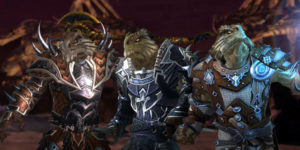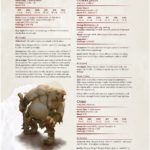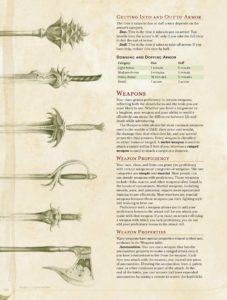GdRItalia vi presenta il seguito dell’intervista a Mike Mearls, capo del team di sviluppo del nuovo Dungeons&Dragons (qui la prima parte), con le ultime cinque domande.
6. Per la scorsa edizione, la Hasbro aveva aperto un portale in cui erano previsti svariati strumenti a beneficio dei giocatori, ma alla fine ne erano usciti solo due (character’s builder e monster’s builder). Ci saranno altri sviluppi per il supporto online? Se sì, che strumenti sono in programma?
Stiamo lavorando con una compagnia chiamata Trapdoor Technologies per produrre strumenti per la quinta edizione. Questi strumenti saranno utilizzabili per PC, iOS e Android. Stanno progettando di lanciare un character builder che possa essere utilizzato anche per gestire i personaggi durante il gioco. Hanno in programma anche degli strumenti per il DM.
7. A parte il playtest, come coniugate l’obiettivo di battere la concorrenza in termini di mantenere alto l’interesse dei vecchi giocatori e la possibilità di attirarne di nuovi?
Per attirare nuovi giocatori dobbiamo concentrarci sui punti di forza dei GdR paragonati ad altri giochi. Narrazione, immaginazione e flessibilità rendono i GdR molto invitanti.
In termini di mercato ci stiamo concentrando molto più sulla narrazione e nel fornire ai giocatori una gamma di prodotti e programmi legati alla storyline annuale, come per esempio Tyranny of Dragons. A ogni nuova storyline i giocatori potranno vedere la storia evolversi sia mediante mediante l’avventura al tavolo, sia con accessori, fumetti, videogiochi, eventi nei negozi e altro ancora. Vogliamo che i giocatori si eccitino per le storyline successive e per i prodotti che le sosterranno. Una nuova pubblicazione dovrebbe rappresentare un’importante pietra miliare per il gioco, qualcosa che sia sulla bocca di tutti i giocatori.

Allacciandosi alla storyline Tyranny of Dragons, è pronto il Dragonborn Legend Pack per il videogioco Neverwinter
8. Ci saranno eventi coordinati come i Living Forgotten Realms o la creazione di una community più sistematica, oltre alle questioni su regole e marketing?
Sì! Il gioco organizzato è d’importanza vitale per noi. Vogliamo vederlo come una gigantesca campagna mondiale in cui ognuno trovi lo stesso livello di libertà e flessibilità di una campagna giocata con gli amici. Le azioni dei giocatori stabiliranno lo sviluppo della storia e, ogni anno, assisterete all’ascesa e alla caduta di possenti mostri, nemici e altre minacce come conseguenza tangibile delle azioni collettive dei giocatori. Per esempio, se una flotta di pirati saccheggia il reame, i giocatori devono fare qualcosa per sconfiggerli. Se un anno i giocatori falliscono nelle avventure, l’anno seguente i pirati saranno più forti. Se li sconfiggono, la minaccia dei pirati svanirà lentamente.

Senza ancora nessuna anteprima dal Monster Manual, l’ogre dello Starter Set è uno dei pochi mostri conosciuti
9. Ci sono regole rapide per creare mostri?
Sì. La Guida del Dungeon Master presenterà linee guida per creare rapidamente i mostri, simili all’approccio della quarta edizione. Potrete anche scegliere un metodo più lungo e dettagliato, se vorrete personalizzare con precisione ogni aspetto di una creatura.
10. Durante il playtest pubblico abbiamo assistito all’introduzione del bonus di competenza collegato alle armi: un personaggio riceve il proprio bonus a colpire con le armi di sua competenza in base al proprio livello. Certi giocatori storcono il naso nel vedere che un mago e un guerriero potrebbero avere la stessa probabilità di colpire un avversario. Questa meccanica è stata risolta?
E’ importante ricordare che, nella quinta edizione, il bonus a un tiro di dado non rappresenta più quanto un personaggio sia diverso dall’altro. In confronto a un mago, un guerriero può recuperare rapidamente punti ferita, attaccare più volte e mettere a segno più colpi critici. Il mago col suo pugnale può avere un bonus di attacco simile, ma il guerriero può batterlo facilmente in un duello armato.
Questo avviene per due importanti motivi.
Primo: quando le cifre salgono troppo rapidamente, obbligano il DM a usare solo mostri forti quanto i personaggi. I mostri più deboli non hanno possibilità di colpire e ferire i personaggi. Con questo nuovo sistema i bonus salgono a un ritmo molto più lento. Quattro goblin sono una sfida per dei personaggi di 1° livello, ma dodici di loro rimangono una minaccia anche al 4° livello. Un party di livello molto alto teme ancora un’orda di orchi.
Secondo: rende molto più facile improvvisare al tavolo. I “numeri” che un DM deve imparare restano gli stessi per tutto il gioco indipendentemente dal livello del party. E’ raro che dei personaggi con bonus più bassi non abbiano nessuna possibilità di successo, anche in un compito difficile. Pertanto i personaggi possono tentare mosse furbe o idee improvvisate indipendentemente dalla propria classe o dall’addestramento. I personaggi specializzati in quel campo hanno sì maggiore probabilità di successo, ma ora non siete più costretti a usare soltanto le vostre specialità per riuscire nelle imprese. Anche le vostre caratteristiche più basse possono rivelarsi utili, perché la differenza tra l’esperto e il personaggio medio è stata ridotta.
Versione originale inglese:
6. In the last edition hasbro opened a portal where different tools to support the player were planned to be, but only two (character’s builder, monster’s builder) were avilable in the end. Will there be more development on the online support? If yes, what other tools are going to be programmed?
We are working with a company called Trapdoor Technologies to produce tools for fifth edition. These tools will be usable on PC, iOS, and Android platforms. They are planning to launch a character builder that can also be used to manage characters during the game. They are also planning on creating tools for the DM.
7. Apart from the play test, how do you conjugate the objective to beat your competitors in terms of maintaining the interest of the all-time players and the possibility to attract new ones?
To attract new players, we must focus on the strengths of RPGs compared to other games. Storytelling, imagination, and flexibility all make RPGs very appealing.
In terms of the market, we are focusing much more on storytelling and providing players with an array of products and programs that tie into the annual storyline (i.e. Tyranny of Dragons.) With every new storyline, players can experience the narrative arc through tabletop gaming adventures and accessories, comic books, digital games, in-store gaming, and more. We want gamers to be very excited for the next storyline and the products that support it. A new release should be an important milestone for the game, something all gamers are talking about.
8. Will there be co-ordinated events like Living Forgotten Realms or the creation of a more systematic community, in addition to rules and marketing questions?
Yes! Organized play is critically important to us. We want to look at it as a giant, worldwide campaign, with everyone involved having the same level of freedom and flexibility as a campaign played with your friends. The players’ actions will dictate how the story develops, and each year you will see the rise and fall of powerful monsters, villains, and other threats in response to the collective actions of the players. As an example, if a fleet of pirates plagues the land, the players must take actions to defeat them. If the players fail in the adventures in one year, the next year the pirates grow stronger. If they defeat them, the pirate menace fades away.
9. Are there any quick rules to create monsters?
Yes. The Dungeon Master’s Guide will present guidelines for quickly building monsters similar to fourth edition’s approach. You will also have the option to take on a longer, more detailed approach if you want to carefully customize each aspect of a monster.
10. During the public playtest we witnessed the introduction of the competence bonus linked to arms: a character receives its own bonus for the goes to hit with the arms of its competence according to its level. Some players stuck up their nose finding out a wizard and a warrior could have the same odds to hit a rival. Has this mechanism been solved?
It is important to remember in fifth edition that the bonus to a die roll is no longer how one character is different from another. A fighter compared to a wizard can quickly regain hit points, attack many times, and score many more critical hits. The wizard with his dagger might have a similar attack bonus, but the fighter can easily defeat him in a duel with weapons.
There are two important reasons for this. First, when numbers increase too quickly it forces the DM to use only monsters that are as strong as the characters. Weaker monsters cannot possibly hit and injure the characters. Under this new system, bonuses increase at a very, very slow rate. Four goblins are a challenge to 1st-level characters, but twelve of them remain a threat even at 4th level. A very high level party is still afraid of a horde of orcs.
Second, it makes improvisation much easier at the table. The target numbers a DM must learn remain the same for the entire game, regardless of the party’s level. Characters with lower bonuses rarely face no chance of success, even with a difficult task. Thus, players can attempt clever actions or improvised ideas regardless of their characters’ class or training. It is true that characters that specialize in an area have a better chance for success, but you are no longer forced to use only your specialties to succeed. Even your weaker abilities can prove useful because the difference between the expert and the average character has been reduced.
Si ringraziano per la collaborazione Alessio Guazzini, Matteo “Gama” Galli e tutti gli altri appartenenti al nostro gruppo Facebook D&D Next Playtester italiani, che hanno curato l’intervista.



